
This month, bobthefunny and the rest of the Commander team return to keep us up to speed on forum news, review Commander 2014, and reflect on bringing new players into a Commander environment.
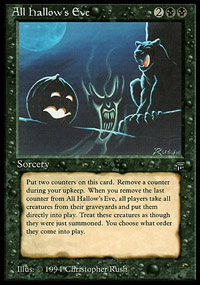
Forum News
Primer Committee News!
- Last month, we added two new members to the Primer Committee and we're back for more this month. You may know scoeri from the Statistical Breakdown of the Commander Metagame, the Statistical Average Deck, and many other threads in the forum. His scripting expertise really helps bring forward a lot of useful information to the forums. scoeri also runs the Decklist Database, and he now joins us in the Primer Committee to help keep track of changes to Primers within the database. Please welcome scoeri to the team!
Top 50 List
- Cryogen runs the Top 50 List, a user-driven list of the top cards in each color. This is not to be confused with Scoeri's statistical breakdown, which lists the more commonly used cards. These past few weeks have covered voting on green creatures and non-creature spells. The lists were also balanced out to hold even card amounts, so the changes are not symmetrical this pass through. The changes are as follows:
Green Non Creatures
Friday Night Magic Changes
- Wizards have recently unveiled an upcoming change to Friday Night Magic: Any format is viable (this means Commander), and the stores now choose how to distribute their prizes. The changes will take effect starting in January, so start talking with your game store now to get sanctioned for it as well as figure out a prize structure. A few ideas around the forums have ranged from giving them out to players with the most kills to distributing them as prizes in league games to distributing them randomly in order to not give players monetary incentive to go all curb stompy in the group. While January may seem far off, you might as well start talking to your group now to discover what will work best for you.
Have a different idea? Talk about it in the comments below!
Holiday Gift Card Exchange 2014
- Look through scoeri’s Statistical Breakdown for some cheap staples that are used a lot.
- Look through cryogen’s Random Card of the Day thread for some interesting and wacky cards.
- Or, look through Rivenor’s Hidden Gem thread for lesser known but interesting and useful goodies.
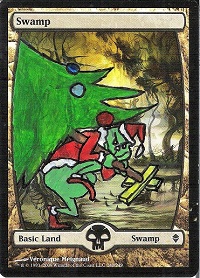
Submissions are now open, so jump into the thread to see some past works and/or PM Jay13x to sign up for participation! Remember to alter the cards personally in some way, and to send enough postage to forward your cards on to the next person!
If you’re having problems thinking of cards to alter, or if you’re on a budget, here are a few ideas:
Of course, the best part is ripping open the packaging to see what you received, so don’t spoil the surprise by posting your alters ahead of time. Do keep a photo though in case the person receiving your gift can’t upload one, and of course show off what goodies you’ve received!
The Commander Releases
- Wizards has been doing a solidly good job with the Commander releases. There was a bit of a snafu last year with the decks being a bit unequal in price tags, with True-Name Nemesis being a good card across several formats. The decks released have always had solid value for Commander players as well. This year continues more of the same, with each deck's reprint value exceeding the MSRP, albeit some more than others.
Of course, each deck has a Sol Ring as well as their respective Medallion, each of which carried a solid price tag before the reprints. All of them carry a Commander's Sphere, which is nice as well assuming they follow the trend that Command Tower has already set.
We'll look into some of the more valuable reprints today, as well as some of the useful but less valuable ones, and then discuss some of the notable new cards. We don't have the space to go over each new card, but every deck has some good highlights worth going over.
Let's begin!
Forged in Stone
I'm personally also very happy with the removal suite in this deck. Both Wing Shards and Return to Dust make it into almost every white deck I own, and Oblation is a solid tuck spell in an emergency. Other highly useful reprints include Mentor of the Meek as one of the best card draw options white has available, Mobilization and Sacred Mesa as phenomenal token producers, and Loxodon Warhammer, one of the more ubiquitous trample equipment out there.
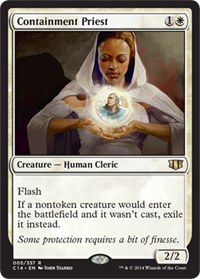
Of course, the two new Commander options are not to be overlooked either. Jazal Goldmane will give a lot of power to White Weenie and token decks, while Nahiri, the Lithomancer will give solid utility to any equipment deck and act as a serviceable token producer.
Building Up:
If you're interested in building the deck up from its base, strengthening the equipment selection will be the first step. The various Swords will pack an effective punch, and O-Naginata is another effective trample enabler. Adding a smattering of tutoring from Stoneforge Mystic, Stonehewer Giant, and Steelshaper's Gift can get the ball rolling. Even Quest for the Holy Relic and Steelshaper Apprentice can pull some good lifting for the deck. The Quest is able to cheat past Argentum Armor's casting cost and equip cost. Once the Apprentice gets himself a pair of greaves, he starts being able to tutor up your whole arsenal very quickly.
I also wouldn't mind seeing some more evasive creatures to suit up. I personally like Soltari Visionary as he doubles as a repeatable answer to enchantments. I also like Spirit en-Dal as an evasion enabler who can suit up in an emergency. A few self-recurring creatures or some artifacts and lands that can animate can also help give a post-wrath presence. A lesser known gem is Genju of the Fields. Early game, it can hold down the fort with an impressive toughness, it self-returns should the land die, and in the late game the ability can be activated multiple times to stack the life gain trigger.
Peer Through Time
I'm happy to also see Willbender in the deck as he can pull some high value in protecting your board state, often ending up as a two for one by redirecting removal. The card draw suite is also nice, with Mulldrifter and Concentrate being solid includes, and Rush of Knowledge as the big ticket draw. Cackling Counterpart is a spell that I often like to draw as well, though I like to pair it with some more enter the battlefield abilities.
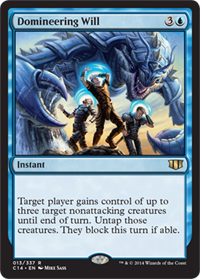
Finally, Teferi, Temporal Archmage is likely one of the more powerful planeswalker commanders. While he has no built-in protection, card draw on a planeswalker is always very powerful, with the +1 ability here being slightly reminiscent of Jace, the Mind Sculptor's Brainstorm, though significantly weaker. Even the -1 ability can set up a lot of value considering the amount of mana-producing artifacts in the deck. Teferi's ultimate produces an extremely powerful emblem, so you can expect to see him in many Superfriends decks as he can ultimate straight off being cast with a Doubling Season out.
Building Up:
My biggest complaint on the blue deck is the lack of any synergy with its big beaters. There isn't much to tie them into the deck or with each other. They are also very high-cost, and can clog up early hands. Luckily, Magic 2015 recently gave us Chasm Skulker, which can drop early and play well with all of the card draw in the deck. Likewise, Diviner's Wand is an equipment that can easily slot into a lot of blue decks, as it can turn any creature into a solid evasive beater. Archaeomancer or Mnemonic Wall can also easily fit in the deck to recover some of the card draw spells and serve as decent clone targets for their enter the battlefield effects.
I also would like to see a bit more to tie into untapping and protecting all those huge mana-producing artifacts that the deck is counting on to ramp up. The artifacts are going to be what will allow the deck to power forward, so a few more counters or recovery options will help to protect against an early Vandalblast. Buried Ruin would be a good budget land to add if you don’t have an Academy Ruins. Trading Post is another good engine to recur artifacts.
Sworn to Darkness
The black deck does round out with some highly useful reprints though, as Bloodgift Demon, Disciple of Bolas, Crypt Ghast, and Butcher of Malakir are solid staples. The removal package is also nice, with Tragic Slip and Sudden Spoiling making it into a number of my own black decks. Mutilate is an excellent board wipe to deal with indestructible creatures. Skeletal Scrying is also a card that I feel is underplayed and I'm happy to see it included as well.
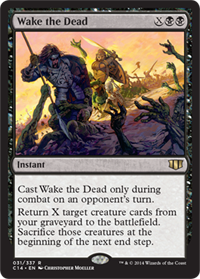
Infernal Offering is one of the better Offerings as it can actually serve as almost three modes, and both parts can be easily negated if needed. The first half can serve as card draw for yourself, but also as removal for a difficult to target creature. If absolutely needed, you can target a player with no creatures to deny the card draw. Likewise, you can target a player with no creatures to deny the reanimation provided by the second part. The best part of the card is that it also has no targets. This means that it is difficult to remove the reanimation options from your graveyard in response. You can reanimate the same creature you sacrificed and the spell cannot be countered from lack of targets by someone the way many other reanimation spells can.
Ob Nixilis of the Black Oath feels like the weakest of the new planeswalkers to me. His emblem is certainly very powerful, but his first ability has little impact and using his second ability immediately puts him very close to death. I can see him used in very control heavy builds where the deck can buy him time to counter up and use the Demon tokens to close out the game.
Building Up:
Sacrificing for fun and profit is nothing new to mono black decks, and my Chainer, Dementia Master deck follows that theme to excess. As such, my viewpoints may be a bit biased. First off, even if not leading up the deck, Chainer is an excellent reanimator option, as is Geth, Lord of the Vault. Some self recurring creatures such as Bloodghast or Reassembling Skeleton will help power up Ghoulcaller Gisa and other sacrifice outlets.
I have also been playing Dark Prophecy in a large number of my decks recently and have been very happy with the advantage it produces, especially in decks designed to watch creatures die on all sides of the field.
If the deck wants to go into a more control style, then the number of wraths can be increased a fair amount. Damnation, In Garruk's Wake, and Decree of Pain can all quickly find a home. Boosting the single target removal with spells like Sudden Death and Dismember can go a long way as well.
Finally, the big mana black is notably missing from the deck. The Magus of the Coffers and Crypt of Agadeem are alright, but they will never replace Cabal Coffers and Nykthos, Shrine to Nyx. Gauntlet of Power and Caged Sun could also make an appearance here.
Built From Scratch
The red deck also includes Caged Sun as a mana doubler, Word of Seizing as one of Red's best "stop that" style of answers, and Reliquary Tower is a land I see a lot in decks around the table.
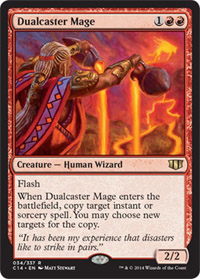
Volcanic Offering makes my list as well as it has absolutely no downside for the caster. It has four-for-one potential and amazing political possibilities as well. Incite Rebellion adds another red board wipe option, but that also can significantly impact token decks by taking out a portion of the player's life total as well.
Both of the new commander options for Red are very good as well. Feldon of the Third Path gives red decks some needed recursion. Daretti, Scrap Savant then brings Goblin Welder into your command zone as a planeswalker. While his +2 ability doesn't have inherent card advantage, pairing it with self-recurring cards such as Squee, Goblin Nabob will increase Daretti's value quite a bit. Even without it, the looting will help improve your card selection, dig you through the deck faster, and also set up graveyard-based play as well. Finally, his ultimate is again another very strong emblem, though it will be much harder for him to arrive there.
Building Up:
The red deck has a lot of synergy built in throughout. I would add to it with a Kiki-Jiki, Mirror Breaker to add to the sacrifice fodder. Likewise, Mirrorworks can bring a lot of added value to the lineup as artifacts enter and leave the battlefield. An inclusion of Karn, Silver Golem can also animate the other artifacts for attacking or other shenanigans such as animating the Wellsprings. A Liquimetal Coating can help create other artifacts to swap out as well as make opposing problem permanents more easy to deal with in red's color pie.
All of the new decks could use a Rings of Brighthearth, but it slots very nicely into this deck, as would Kurkesh, Onakke Ancient. These would both also help boost the Wayfarer's Bauble for mana acceleration as well as double up the draw options in the deck.
Guided by Nature

Finally, Freyalise, Llanowar's Fury rounds out the last planeswalker slot. Her +2 combines the typical green planeswalker options of making tokens and mana. I like that her tokens do more than just take up protective space as vanilla chump blockers, as they have relevant types and mana ability. Her -2 Naturalize ability will add a lot of good removal on the board, as it will even serve as a strong deterrent to having those threats even hit the field. Finally, her ultimate is not too difficult to reach, and while it won't win the game, it adds in a great value of card advantage. Overall, Freyalise doesn't overwhelm on any front, but is a solid, well-rounded planeswalker. Pairing her with green's token doublers, Rings of Brighthearth, or The Chain Veil will also lead to a flood of quick mana production.
Building Up:
Elfball decks are always a bit fragile to board wipes, so some additional recovery would be the first thing I would look into here. Either the ability to draw back off of the reset with Fecundity or to recur cards with Creeping Renaissance would fit in well here. Some extra tutoring from Citanul Flute or Skyshroud Poacher can add a bit more resilience to the deck.
If you're more interested in boosting the elf token theme, adding in Parallel Lives and Doubling Season can help fill that army more quickly. Finally Kamahl, Fist of Krosa adds a back up to Ezuri as a repeatable Overrun effect.
Welcoming New Commanders!
- A release of the Commander product always brings in a new influx of Commander players of all experience levels of Magic. You shouldn't be surprised if there is some new blood swinging into your game store looking for a game. With the additional exposure of the recent Friday Night Magic change allowing Commander to be sanctioned on top of that starting in January, you may see a few more new faces than normal. So, how to welcome another player at the table?
- Don't build the deck around specifics: The more narrow you build the play style of the deck, the less broad a range of players can connect with it. This is why generally termed "goodstuff" decks tend to make the best loaner decks. The pilot can shift it into their own style without being forced down a specific road. On the opposite side, control and combo decks tend to make worse loaner decks if the player you're loaning them out to is not typically a pilot of those archetypes. Combo and control also both tend to embrace a more passive play style, and most new players want to be more active in the game rather than less.
- Avoid unconditional tutors: In fact, it would be best if you can avoid any nonbasic land tutoring. When you play a deck you build yourself, you at least know what each will do by sight even if you don't remember every card you put into the deck. A new player, and even some experienced players, will not know each of those cards by sight or how they tie into the theme of the deck. I've had some success with loaning out Treasure Mage, Trinket Mage, and various equipment tutoring packages, but only when they were limited in scope. I usually also gave some key targets they could look for, such as Nihil Spellbomb as graveyard hate for Trinket Mage.
- Overstate card draw: Since you're shorting out on tutor spells, you need to compensate with more card draw naturally. Additional card draw means that the player piloting the deck will also never run out of gas. Again, this ties in to players enjoying being more active rather than passive in a game. If they get stuck in topdeck mode, their impressions of the game will drop drastically.
- Finally, build in protections against over-extension: A common play error when playing a new deck is not knowing when you're over-committing. When building a loaner deck, I try to include card draw across multiple permanent types so that a single permanent type sweeper will not set them back too much. I also include a number of creatures that are naturally resilient to wrath effects with abilities such as persist, undying, or indestructible. These will ensure the pilot still has board presence even after overextension.
Not only is Commander a specialized set of rules added on to Magic, but it's also a very social game and there are a lot of subtle nuances from one group to the next. Learning the multiplayer dynamics of a new group is a large undertaking, especially if that person is learning Commander for the first time. As with any social activity, the most important thing is communication. Whenever I sit down to a game with a new player, and sometimes even regulars, I always ask what kind of game they are looking for and try to pick a deck from my collection that will fit.
Giving Feedback
Finding the right deck to play against a new player can always be tough. This can be even more true if they are entering the format from the preconstructed decks. While the decks will provide a solid foundation, there is a lot of work to actually making the deck personalized and able to fit into a specific playgroup. Be open with giving feedback and suggestions. Tips from the playgroup are the most relevant, since those are the players the person will need to go up against. If a playgroup is more wrath-happy, maybe the inclusion of more resilient threats is a better investment than the "standard" inclusions.
Another part of giving feedback though is being able to receive it. Every new player that joins a playgroup brings new experiences, likes, and dislikes. While the player should certainly try to keep in mind the rest of the group’s expectations for games, that person is now part of the group and their likes and dislikes will now also affect how the games are played. Ask what the player's favorite and least favorite parts of the game are and be open to adapting yourself as well as helping them overcome their difficulties.
Building a Loaner Deck
Whether a new group member is a starting player with a Commander preconstructed deck or an experienced player coming in from out of town lacking a deck of the right power level, there is an elegant solution to giving them more variety to experience, as well as ensuring games within the level of play you expect: building a loaner deck.
I've loaned a number of my decks out over the years and a few points stand out on things to consider when building a loaner deck:
These past few weeks I've been pulling together a new loaner deck: Anafenza, the Foremost. My previous loaner deck of Stonebrow, Krosan Hero/Ruric Thar, the Unbowed was a solid beat-'em-up style deck, but the card draw and removal felt very unpredictable. Anafenza allows me to highlight cards from the newer sets, which shows new players recognizable cards that they can build off of in their own collections, while mixing in some older cards with interesting and unique abilities.
The deck features multiple avenues for victory, though all are creature-based. Powerhouses like Hero of Bladehold can put pressure on early as well as support a larger army play. A smattering of equipment allows even solitary creatures to punch through defending creatures. Several enchantments allow post-wrath board presence and some token opportunities. Offsetting persist counters with Anafenza's ability allows for a slight combo touch. This is all backed by a solid removal suite to support both aggressive and control uses. With a touch of recursion and a heavy suite of card draw, the pilot of this deck should never have to worry about running out of gas, although there are few enough ways to replenish life, which may be a future consideration for improvements considering how much I rely on black's use of life as a resource for card draw.
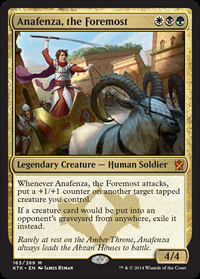
Moderator Experiences:
This space
intentionally
left blank
intentionally
left blank
- Walking into a new playgroup is always a different experience, but when I went to college none of my immediate friends played Magic… at first. Over those first two years we formed a new playgroup, made entirely of new players, excluding myself. Holding back and making goofier decks was a bit difficult for me, as I tend to be a bit more competitive by nature, but the multiplayer environment really helped to curtail how insane I could go. Overall, it was interesting seeing a group start out from scratch, as deck evolution followed a very close rock-paper-scissors mentality, as one player quickly leaned towards crazy combos, which led another to running much more cut-throat aggro, etc.
The real test, though, came when we discovered another playgroup on campus and we accepted an invitation to go play. Like our group, it was a close group of friends, most of whom were fairly new to the game except for one player who routinely proxied the Power Nine. Their group had essentially devolved into playing for second place in convoluted board states, especially as no other player proxied cards or even followed tournament decks and strategies.
A few of my friends were ready to call it quits with that group right then and there after that first night. Instead, I persisted and suggested we try and open communication instead because what I had noticed was that since we split into two groups due to the size of the group, some of the other group members were having genuine fun of a type they hadn't really had in their previous games for quite a while.
I took aside the player to speak with him, and initially the talks didn't go well. He didn't see the problem, he didn't see why he should play down his potential and so on. Again, I persisted. If he wanted a challenge and to play to his potential then he and I could play some one-versus-one games, but there was no need to bring that level of power and play to a new group of players. Finally, he accepted giving it a try.
Over the next few months, the group got together more than a few times. There was definitely some strong rivalry between our decks as our single minded focus of killing the other at all costs typically got us both eliminated early on, but the games were awesome, and everyone had fun.
- Commander is a unique format in which above everything else, the goal of the game for each player to create an experience for all players which will make them want to continue playing the format. I suppose that is a generic goal which could be applied for literally every game, but I think you get what I'm saying. The reward for playing should be group enjoyment over winning. Now, established groups tend to find a natural equilibrium which the players can agree on, but what happens when you get a new player who wants to join the group? For anyone who has played Dungeons and Dragons or similar games, you might be familiar with the answer. First and foremost, create an environment in which the new player feels comfortable. Welcome them to the group, encourage them to participate, and let them be themselves, especially since if there are any negative traits you want to be able to address them before the player feels too established. Next, determine what type of player they are. Are they brand new to the game and need help building their first deck, then help walking them through the mechanics? Or are they an established player? Both come with their own perils, which I'll address separately.
Brand New Players: A brand new player has two strikes against him or her right off the bat. First, they are not enfranchised yet, so if their first experience is a bad one, they are unlikely to continue playing. Second, there is a very good chance that they will slow down the rest of the more experienced group. We see this all the time, whether it's stopping to read a card that "everyone knows", or not understanding basic rules of the game. However, the good news is that it is a lot easier to cater to a new player. No matter whether they are playing their preconstructed deck they just unwrapped or are borrowing your $10,000 foiled out five-color Hermit Druid combo deck, their piloting skills will ensure they are not much of a threat. As such, the other players should play accordingly and not overwhelm the new player. Remember, if you are fortunate enough to find a new player which you all want to be a part of your group, you will have ample time to help them improve and get to more of an even level with the rest of the group.
So what's the answer? Well, in all scenarios, I think that patience is the key. Change doesn't happen in one session, and everyone in the group needs time to warm up to everyone else. Red flags like obnoxiousness or aggressiveness should be addressed immediately, but smaller things such as in-game problems or minor character flaws can usually be addressed over time. And remember that two-way street I briefly mentioned? Try it out. Stax games every game every week suck, but there is a rewarding challenge to overcome. I'm not trying to use this as an opportunity to stand on a soapbox, but being accepting of a player who enjoys something you don't will make them more likely to want to change and play with the group rather than against it. Heck, if that über-oppressive deck just plain sucks for the rest of the group, turn that game into a co-op Archenemy game.
One Final Thought: In all this I have been using the assumption that it is a private group in which the new player joins. What if it is a public group? Well, there are a couple of minor differences, but also some similarities. First and foremost, if they are a generally unpleasant person, handle it on the spot. The difference is that in a public place like an LGS, it isn't your job to kick someone out. Talk to the staff and explain the situation. Let them do their job and deal with unpleasant people. But what if it is an in-game problem like competitive differences? If you're a group playing pickup games in a store, you handle it like I described earlier. But if your group is something established by the store, such as a league or competitive event, you deal with it. No, seriously. This player is paying money in order to compete, and there are established rules to mitigate and discourage certain play. If that player is being antisocial to the point of ruining it for everyone else, it still isn't your job to confront that player. Talk to the staff or event organizer. Their job is to create an environment that attracts participation, so if someone is harming that then they should be the ones to handle it.
- I had recently moved to a college town for a job. I showed up at the college for game night and I was trying to feel things out. I happened to ask if anyone played Commander and a few people mentioned that they played. I mentioned that I play fairly regularly myself and they went and got a buddy of theirs saying that I had to play against him as apparently he was the guy to beat in their meta. I sort of took it as a situation where he must have some fairly good decks due to the hype that they were giving him, so I pulled out my Jenara deck to sort of test him out. We started playing the game and I remember the decks that I was up against being something like $50.00 - $75.00 sort of decks vs. my $2,000+ at the time Jenara list. The short end to the story is that the way they were talking him up lead me to overestimate what I was playing against. I ended up having to scale way back to the point that I had to pull out my pauper Commander decks to play against them, and the sad part is I almost won that if not for some creature theft effect that stole my commander. From this I learned the lesson that there are a lot of different expectations in the game.
I went to my first GP earlier this summer for the sole purpose of picking up games of Commander. I ended up finding a group of guys and playing several games with them throughout the weekend. It was the last day and so many of those there were doing side events and such at this point. We ended up kicking into a few pods of games with two new individuals that came down that owned a local store. The other player was one that we had kicked a few games around with already. We sat down to play a four player free for all game where it became apparent quickly that the two that owned the local store were fans of collusion and as long as one of them won they didn't care. Literally everything they did was targeting the other two of us even when I was down and being kicked they kept at me. The other guy who came with me from the other games ended up casting a Fact or Fiction targeting me which I 5-0ed for him because we had officially entered a game of two-versus-two. In the end, the mono blue player that came with me ended up establishing a board state of a fully leveled Lighthouse Chronologist with Capsize on triple mana-producing lands. He closed the game out and I actually felt proud that he overcame the two collusive players.
- As a social format, your playgroup is the most important aspect of Commander play. Sure, you could build a deck and take it to the side events at a Grand Prix, but if that's all you're doing, you're missing out on easily half of the joy of the format. For those of you without a regular playgroup, you might wonder how to form one. Here are some tips.
Check your Local Gaming Stores: Many game stores will run a Casual and/or Commander night one day of the week. If there isn't one, you should try talking to your local game store owner and seeing if you can convince him to start one. Some store owners may be reluctant to host such a night, as Commander players are not paying tournament entry, but when there are players hanging out in a store, they're going to buy things. A couple packs of sleeves, some singles, soda, dice, deck boxes, and even the occasional pack adds up when you've got a dozen or more players showing up weekly. If that doesn't win the store owner over, you can suggest a League structure, where players pay in a small amount that goes towards prizes, awarded primarily for achievements in and out of game. If you're pitching a Commander night, it's a good idea to try to put it on a night where the store doesn't have a lot of other activities going on. Ideally, you will also want to stagger it so it doesn't line up with any Commander nights in the nearby area, so as not to divide the player base.
Internet Groups: It helps to get the word out as many ways as you can. My personal playgroup uses a Facebook group, which keeps the members informed of when the next meet up will be, who will be there, and so forth. Players can request trades, share deck list ideas, and discuss new cards. If you're looking to recruit new people into your group, you could try posting to a site like meetup.com, which unites people with common interests.
Helping New Players: Often you will encounter players who are interested in Commander but haven't yet played it. There are several good ways to help them get into it. If you have the collection to support it, building a few loaner decks is a great idea. You can let the new player use your deck to get a feel for the format. It generally doesn't take more than a few games to get hooked. The official Commander decks releasing every year now are a great starting point once a player decides they want to get into a format. Even just helping new players out by providing some old yet common staples like Cultivate and Sakura-Tribe Elder can go a long way.
Trick or Treat?
Well, this month's article has covered a lot of ground in the happenings of Commander as we've had a lot of topics to cover. Once you get to open up your new Commander decks, come back here and let us know about your favorite and what tweaks you've made to improve it.
-
View User Profile
-
Send Message
Posted Nov 23, 2014You are either quite lucky or quite persuasive, bobthefunny! In my experience, as a dedicated casual EDHer for the past few years, there is no firmer divide than the one between casual EDHers and those players I call "Killer Commanders". Ie., the people who can't imagine why anyone might have a problem with their deck that packs 15 tutors and reliably combos out by turn four, etc., etc. Back before it was banned I knew this guy who couldn't see a problem with bringing in Sundering Titan on turn three and flickering it every turn (and man, did he put up a fuss when it finally got the axe). In my experience, "Killer Commanders" not only refuse to see how their kind of fun spoils other players' / casual players' fun, their typical reactions to having this pointed out to them are either to get defensively angry ("how-dare-you-try-to-ruin-my-fun"), or react with arrogant contempt (the old "you're-just-sore-because-you-aren't-good-enough-to-compete" attitude).
It's gotten to the point that I simply don't have the patience or willingness to try to bridge this gap any more. When I meet strangers at a game store, I tend to stand back and watch their Commander pods / tables for a while to get a sense of what sort of players frequent the joint. If I identify a group or pod that is populated by Killer Commanders, I don't even bother sitting down. Why set myself up for the frustration? I identify the casual players, wait until they've been eliminated (which of course they generally are first), then start a pod with them. This works out great for everyone since by the time the spikes are finished with their pods, we will still be playing, so the spikes wind up shrugging and starting their own pod together... and then everyone has been more or less sorted into groups that keep everyone happy.
I have had great success with this method and it's quite useful for teaching newbies as well. Even newbies who will eventually wind up in the spike camp, aren't going to learn anything about EDH from a game that only lasts five minutes. Casual pods are a better learning environment for them.
-
View User Profile
-
Send Message
Posted Dec 3, 2014In smaller environments where you may only have one or two pods going though, it can be a bit more difficult. Also, you then get problematic players like me who like to play across the entire spectrum.
I also believe that casual environments can provide excellent learning areas, but you have to be careful of it as well. One trap that my own group has been running into now is being too lenient on take-backs. Originally implemented to allow the newer players some freedom of thought and to help them work through what courses of actions to take. It can start to be abused into not fully thinking through a situation. An example being that one player cast Council's Judgment to remove my Commander. The second player voted for another permanent in order to set up a double exile option for player C, and player C then mistakenly selected a third permanent for more exily goodness, at which point I selected one of the other targets for my vote in order to save my Commander. Player C hadn't really thought things through (and I'd also quickly jumped the gun on my own vote, I'll admit), but we ended up rewinding that play so he could properly select his vote.
I find it helps best to properly (and as honestly as possible) represent the board state for newer players. For example, with cards with the Will of The Council, such as Council's Judgment, I find that it helps to explain to newer players what the consequence of their vote will do to the options the next player in line will be able to make. After a while, you can scale back the aid you give to after the play or game is over, that way they can learn from their own choices, but still have the benefit of a different viewpoint.
In one game, my brother should have had lethal on me since he had a pro-black creature, and he was paranoid about a Duplicant in my Chainer deck's graveyard... except that he misplayed having forgotten that Chainer would reanimate it as a black creature and opted to spread his equipments out instead. Since my brother should have known better, that was an observation I made at the end of the game (a few turns later). He has never forgotten it again.
These kinds of interactions though can really help all players improve their own levels of play.
-
View User Profile
-
Send Message
Posted Nov 8, 2014I'm glad you enjoyed the article.
-
View User Profile
-
Send Message
Posted Nov 8, 2014